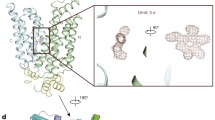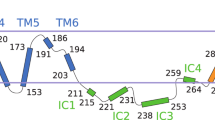Abstract
A growing body of evidence demonstrates that GLUT1-mediated erythrocyte sugar transport is more complex than widely assumed and that contemporary interpretations of emergent GLUT1 structural data are incompatible with the available transport and biochemical data. This study examines the kinetic basis of one such incompatibility—transport allostery—and in doing so suggests how the results of studies examining GLUT1 structure and function may be reconciled. Three types of allostery are observed in GLUT1-mediated, human erythrocyte sugar transport: (1) exofacial cis-allostery in which low concentrations of extracellular inhibitors stimulate sugar uptake while high concentrations inhibit transport; (2) endofacial cis-allostery in which low concentrations of intracellular inhibitors enhance cytochalasin B binding to GLUT1 while high concentrations inhibit binding, and (3) trans-allostery in which low concentrations of ligands acting at one cell surface stimulate ligand binding at or sugar transport from the other surface while high concentrations inhibit these processes. We consider several kinetic models to account for these phenomena. Our results show that an inhibitor can only stimulate then inhibit sugar uptake if (1) the transporter binds two or more molecules of inhibitor; (2) high-affinity binding to the first site stimulates transport, and (3) low-affinity binding to the second site inhibits transport. Reviewing the available structural, transport, and ligand binding data, we propose that exofacial cis-allostery results from cross-talk between multiple, co-existent ligand interaction sites present in the exofacial cavity of each GLUT1 protein, whereas trans-allostery and endofacial cis-allostery require ligand-induced subunit–subunit interactions.












Similar content being viewed by others
References
Kasahara M, Hinkle PC (1977) Reconstitution and purification of the d-glucose transporter from human erythrocytes. J Biol Chem 252:7384–7390
Baldwin JM, Gorga JC, Lienhard GE (1981) The monosaccharide transporter of the human erythrocyte. Transport activity upon reconstitution. J Biol Chem 256:3685–3689
Lloyd KP, Ojelabi OA, De Zutter JK, Carruthers A (2017) Reconciling contradictory findings: glucose transporter 1 (GLUT1) functions as an oligomer of allosteric, alternating access transporters. J Biol Chem (in press)
Ojelabi OA, Lloyd KP, Simon AH, De Zutter JK, Carruthers A (2016) WZB117 inhibits GLUT1-mediated sugar transport by binding reversibly at the exofacial sugar binding site. J Biol Chem 291:26762–26772
Hamill S, Cloherty EK, Carruthers A (1999) The human erythrocyte sugar transporter presents two sugar import sites. Biochemistry 38:16974–16983
Robichaud T, Appleyard AN, Herbert RB, Henderson PJ, Carruthers A (2011) Determinants of ligand binding affinity and cooperativity at the GLUT1 endofacial site. Biochemistry 50:3137–3148
Cloherty EK, Levine KB, Carruthers A (2001) The red blood cell glucose transporter presents multiple, nucleotide-sensitive sugar exit sites. Biochemistry 40:15549–15561
Sultzman LA, Carruthers A (1999) Stop-flow analysis of cooperative interactions between GLUT1 sugar import and export sites. Biochemistry 38:6640–6650
Lieb WR, Stein WD (1974) Testing and characterizing the simple carrier. Biochim Biophys Acta 373:178–196
Jardetzky O (1966) Simple allosteric model for membrane pumps. Nature 211:969–970
Widdas WF (1952) Inability of diffusion to account for placental glucose transfer in the sheep and consideration of the kinetics of a possible carrier transfer. J Physiol 118:23–39
Baker GF, Widdas WF (1973) The asymmetry of the facilitated transfer system for hexoses in human red cells and the simple kinetics of a two component model. J Physiol 231:143–165
Baker GF, Naftalin RJ (1979) Evidence of multiple operational affinities for d-glucose inside the human erythrocyte membrane. Biochim Biophys Acta 550:474–484
Nomura N, Verdon G, Kang HJ, Shimamura T, Nomura Y, Sonoda Y, Hussien SA, Qureshi AA, Coincon M, Sato Y, Abe H, Nakada-Nakura Y, Hino T, Arakawa T, Kusano-Arai O, Iwanari H, Murata T, Kobayashi T, Hamakubo T, Kasahara M, Iwata S, Drew D (2015) Structure and mechanism of the mammalian fructose transporter GLUT5. Nature 526:397–401
Deng D, Xu C, Sun P, Wu J, Yan C, Hu M, Yan N (2014) Crystal structure of the human glucose transporter GLUT1. Nature 510:121–125
Quistgaard EM, Löw C, Moberg P, Trésaugues L, Nordlund P (2013) Structural basis for substrate transport in the GLUT-homology family of monosaccharide transporters. Nat Struct Mol Biol 20:766–768
Sun L, Zeng X, Yan C, Sun X, Gong X, Rao Y, Yan N (2012) Crystal structure of a bacterial homologue of glucose transporters GLUT1–4. Nature 490:361–366
Cunningham P, Naftalin RJ (2014) Reptation-induced coalescence of tunnels and cavities in Escherichia coli XylE transporter conformers accounts for facilitated diffusion. J Membr Biol 247:1161–1179
Cunningham P, Naftalin RJ (2013) Implications of aberrant temperature-sensitive glucose transport via the glucose transporter deficiency mutant (GLUT1DS) T295M for the alternate-access and fixed-site transport models. J Membr Biol 246:495–511
Topham CM, Brocklehurst K (1992) In defence of the general validity of the Cha method of deriving rate equations. The importance of explicit recognition of the thermodynamic box in enzyme kinetics. Biochem J 282:261–265
Cha S (1968) A simple method for derivation of rate equations for enzyme-catalyzed reactions under the rapid equilibrium assumption or combined assumptions of equilibrium and steady state. J Biol Chem 243:820–825
Carruthers A, Helgerson A (1991) Inhibitions of sugar transport produced by ligands binding at opposite sides of the membrane. Evidence for simultaneous occupation of the carrier by maltose and cytochalasin B. Biochemistry 30:3907–3915
Helgerson AL, Carruthers A (1987) Equilibrium ligand binding to the human erythrocyte sugar transporter. Evidence for two sugar-binding sites per carrier. J Biol Chem 262:5464–5475
Gorga FR, Lienhard GE (1981) Equilibria and kinetics of ligand binding to the human erythrocyte glucose transporter. Evidence for an alternating conformation model for transport. Biochemistry 20:5108–5113
Stein WD (1986) Transport and diffusion across cell membranes. Academic Press, New York
Carruthers A (1990) Facilitated diffusion of glucose. Physiol Rev 70:1135–1176
Baldwin SA, Baldwin JM, Lienhard GE (1982) Monosaccharide transporter of the human erythrocyte. Characterization of an improved preparation. Biochemistry 21:3836–3842
Naftalin RJ, Holman GD (1977) Transport of sugars in human red cells. In: Lew VL, Ellory JC (eds) Membrane transport in red cells. Academic Press, New York, pp 257–300
Cura AJ, Carruthers A (2012) Role of monosaccharide transport proteins in carbohydrate assimilation, distribution, metabolism, and homeostasis. Compr Physiol 2:863–91439
Carruthers A, De Zutter J, Ganguly A, Devaskar SU (2009) “Will the original glucose transporter isoform please stand up!”. Am J Physiol Endocrinol Metab 297:E836–E8489
Zottola RJ, Cloherty EK, Coderre PE, Hansen A, Hebert DN, Carruthers A (1995) Glucose transporter function is controlled by transporter oligomeric structure. A single, intramolecular disulfide promotes GLUT1 tetramerization. Biochemistry 34:9734–9747
Hebert DN, Carruthers A (1992) Glucose transporter oligomeric structure determines transporter function. Reversible redox-dependent interconversions of tetrameric and dimeric GLUT1. J Biol Chem 267:23829–23838
Vollers S, Carruthers A (2012) Sequence determinants of GLUT1-mediated accelerated-exchange transport—analysis by homology-scanning mutagenesis. J Biol Chem 287:42533–42544
Krupka RM, Devés R (1981) An experimental test for cyclic versus linear transport models. The mechanisms of glucose and choline transport in erythrocytes. J Biol Chem 256:5410–5416
Blodgett DM, Carruthers A (2005) Quench-flow analysis reveals multiple phases of GluT1-mediated sugar transport. Biochemistry 44:2650–2660
Helgerson AL, Carruthers A (1989) Analysis of protein-mediated 3-O-methylglucose transport in rat erythrocytes: rejection of the alternating conformation carrier model for sugar transport. Biochemistry 28:4580–4594
Blodgett DM, De Zutter JK, Levine KB, Karim P, Carruthers A (2007) Structural Basis of GLUT1 Inhibition by Cytoplasmic ATP. J Gen Physiol 130:157–168
Heard KS, Fidyk N, Carruthers A (2000) ATP-dependent substrate occlusion by the human erythrocyte sugar transporter. Biochemistry 39:3005–3014
Carruthers A, Helgerson AL (1989) The human erythrocyte sugar transporter is also a nucleotide binding protein. Biochemistry 28:8337–8346
Afzal I, Browning JA, Drew C, Ellory JC, Naftalin RJ, Wilkins RJ (2004) Effects of anti-GLUT antibodies on glucose transport into human erythrocyte ghosts. Bioelectrochemistry 62:195
Afzal I, Cunningham P, Naftalin RJ (2002) Interactions of ATP, oestradiol, genistein and the anti-oestrogens, faslodex (ICI 182780) and tamoxifen, with the human erythrocyte glucose transporter, GLUT1. Biochem J 365:707–719
Sage JM, Cura AJ, Lloyd KP, Carruthers A (2015) Caffeine inhibits glucose transport by binding at the GLUT1 nucleotide-binding site. Am J Physiol Cell Physiol 308:C827–C834
De Zutter JK, Levine KB, Deng D, Carruthers A (2013) Sequence determinants of GLUT1 oligomerization: analysis by homology-scanning mutagenesis. J Biol Chem 288:20734–20744
Kapoor K, Finer-Moore JS, Pedersen BP, Caboni L, Waight A, Hillig RC, Bringmann P, Heisler I, Müller T, Siebeneicher H, Stroud RM (2016) Mechanism of inhibition of human glucose transporter GLUT1 is conserved between cytochalasin B and phenylalanine amides. Proc Natl Acad Sci USA 113:4711–4716
Colquhoun D, Dowsland KA, Beato M, Plested AJ (2004) How to impose microscopic reversibility in complex reaction mechanisms. Biophys J 86:3510–3518
Acknowledgements
This work was supported by NIH Grants DK36081 and DK44888.
Author information
Authors and Affiliations
Corresponding author
Rights and permissions
About this article
Cite this article
Lloyd, K.P., Ojelabi, O.A., Simon, A.H. et al. Kinetic Basis of Cis- and Trans-Allostery in GLUT1-Mediated Sugar Transport. J Membrane Biol 251, 131–152 (2018). https://doi.org/10.1007/s00232-017-0006-7
Received:
Accepted:
Published:
Issue Date:
DOI: https://doi.org/10.1007/s00232-017-0006-7




